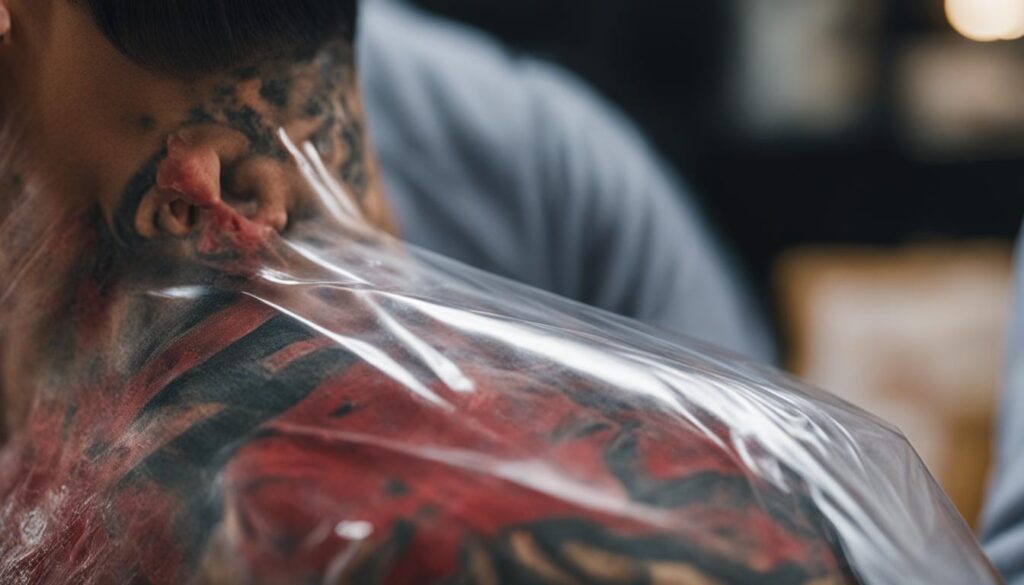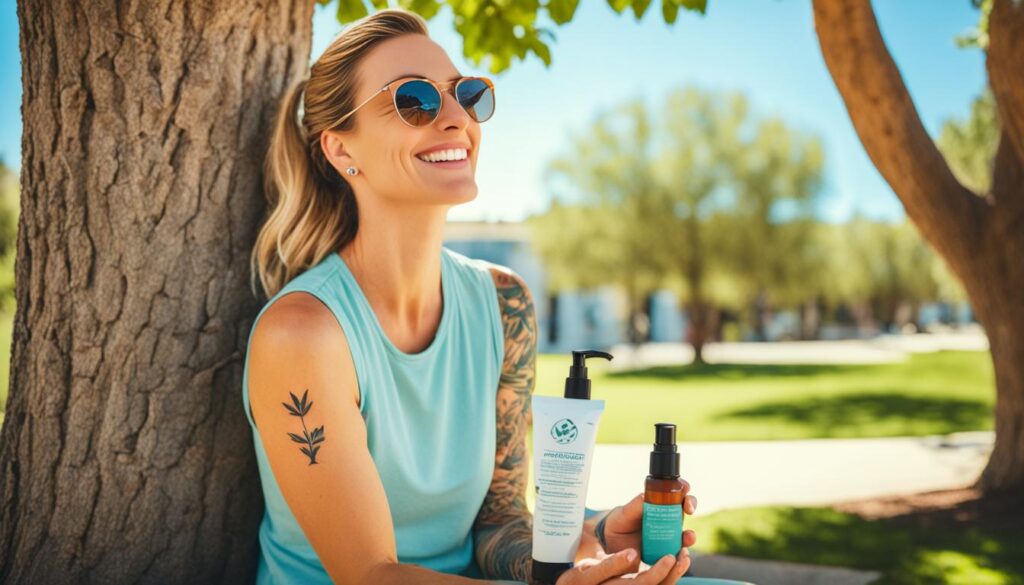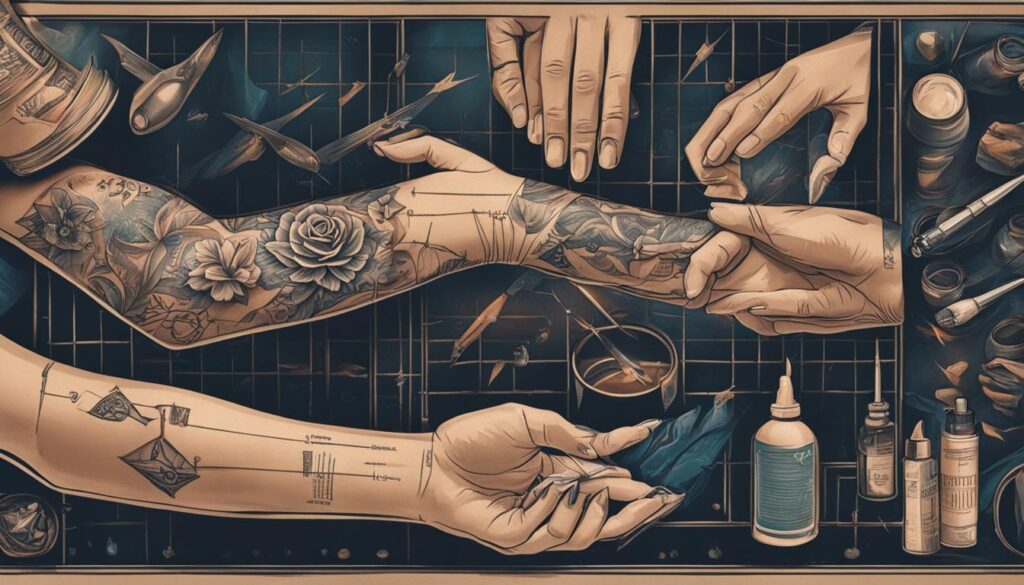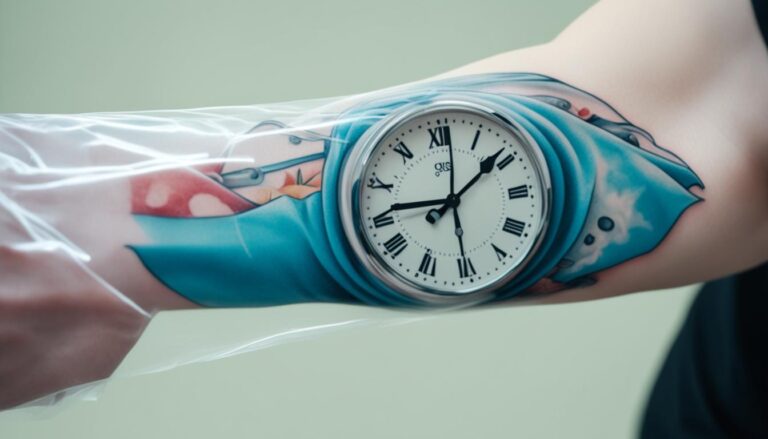When it comes to getting a new tattoo, proper aftercare is essential for ensuring optimal healing and long-lasting results. One important aspect of tattoo aftercare is determining how long to keep your tattoo covered. In this section, we will explore the optimal duration for covering up your new tattoo and provide expert advice and guidelines to help you make informed decisions.
During the initial healing period, it is crucial to protect your tattoo from external factors that can hinder the healing process. By keeping your tattoo covered appropriately, you can prevent bacteria, dirt, and friction from interfering with the healing process.
The exact duration for keeping your tattoo covered may vary depending on the advice provided by your tattoo artist. However, a general recommendation is to keep it covered for the first 24 to 48 hours after getting inked. This initial period is crucial for reducing the risk of infection and ensuring optimal healing.
Once this initial period has passed, you can carefully uncover your tattoo and start following the proper care instructions. It’s important to clean the tattooed area gently and use recommended products for tattoo aftercare.
Throughout the healing process, it’s essential to closely monitor the progress of your tattoo’s healing. If you have any concerns or notice any issues, it’s always recommended to seek professional advice from your tattoo artist or a dermatologist to ensure proper care.
By following the recommended duration for keeping your tattoo covered and maintaining proper aftercare practices, you can support the healing process and achieve vibrant, long-lasting results. Remember to always consult with your tattoo artist for personalized aftercare instructions and keep up with regular touch-ups to keep your tattoo looking its best for years to come.
Tattoo Healing Process and Timeframe
Understanding the tattoo healing process is crucial for determining the appropriate duration to keep your tattoo covered. Healing time can vary for each individual, but on average, it takes about two to four weeks for a tattoo to fully heal and settle. During this period, your tattoo goes through several stages of healing, which require proper care and protection.
Tattoo Healing Stages
Let’s take a closer look at the different stages involved in the tattoo healing process:
- Stage 1: Inflammation – Immediately after getting your tattoo, the area will be red, swollen, and tender. This is a normal inflammatory response as your body begins the healing process.
- Stage 2: Scabbing and Peeling – Within a few days, the tattooed area may develop scabs. It’s crucial to resist the temptation to pick or scratch these scabs, as it can lead to scarring or uneven healing. As the scabs naturally fall off, the tattooed skin may also start to peel.
- Stage 3: Itching and Dryness – As the tattooed skin continues to heal, you may experience itching and dryness. It’s important to resist scratching or applying excessive moisturizer, as it can disrupt the healing process.
- Stage 4: Settling and Fading – Over time, your tattoo will settle into the skin, and the colors may fade slightly. This is a natural part of the healing process, and the final result will typically be revealed after a few weeks.
Throughout these stages, it’s crucial to follow proper tattoo care instructions to promote healing and maintain the quality of your tattoo.
Tattoo Healing Tips
Here are some essential tips to ensure a smooth healing process for your tattoo:
- Keep your tattoo clean and dry. Avoid soaking it in water, excessive sweating, or exposing it to direct sunlight.
- Gently wash the tattooed area with a mild, fragrance-free soap and lukewarm water, using your fingertips. Pat dry with a clean towel instead of rubbing the area.
- Apply a thin layer of fragrance-free, non-comedogenic moisturizer or a tattoo-specific aftercare product recommended by your tattoo artist. Avoid using petroleum-based ointments or heavy creams that can clog pores.
- Avoid wearing tight clothing or accessories that can rub against your tattoo and cause irritation.
- Refrain from picking, scratching, or peeling any scabs or flaking skin.
- Avoid exposing your healing tattoo to pools, hot tubs, saunas, or any other bodies of water that may harbor bacteria.
By following these tattoo healing tips and allowing the necessary time for your tattoo to heal, you can ensure long-lasting, vibrant results.

| Tattoo Healing Timeframe | Approximate Duration |
|---|---|
| Stage 1: Inflammation | 1-2 weeks |
| Stage 2: Scabbing and Peeling | 1-2 weeks |
| Stage 3: Itching and Dryness | 1-2 weeks |
| Stage 4: Settling and Fading | 1-2 weeks |
Importance of Keeping a Tattoo Covered
Covering your tattoo during the initial healing period is crucial for its protection against bacteria, dirt, and other external factors. It also helps prevent friction and irritation that can hinder the healing process. To ensure the best possible outcome for your new tattoo, it’s important to follow these tattoo care guidelines:
- Keep your tattoo covered: It is recommended to keep your tattoo covered for the appropriate period as advised by your tattoo artist.
- Choose the best way to protect your new tattoo: Use a sterile, non-stick dressing or a breathable tattoo bandage to cover your tattoo.
- Protect your tattoo at night: Consider keeping your tattoo covered at night, especially during the initial healing stages, to prevent accidental rubbing or scratching.
- Follow proper bandaging techniques: When applying a tattoo bandage, ensure it is clean and sterile. Avoid wrapping it too tightly to allow proper airflow.
By keeping your tattoo covered, you create a barrier against potential contaminants, reducing the risk of infection and promoting faster healing. Remember to always follow the specific aftercare instructions given by your tattoo artist to ensure the best results.
“Covering your tattoo during the initial healing period is crucial for its protection against bacteria, dirt, and other external factors.”
Remember to consult your tattoo artist for personalized aftercare instructions and advice on the best practices to follow during the covering up new tattoo period. Continue reading to learn about the recommended duration for tattoo coverage in the next section.

Recommended Duration for Tattoo Coverage
When it comes to caring for your new tattoo, knowing how long to keep it covered is essential. While the exact duration may vary based on your tattoo artist’s advice and the specific tattoo placement, a general recommendation is to keep your tattoo covered for the first 24 to 48 hours after getting inked.
This initial period is crucial for reducing the risk of infection and ensuring the optimal healing of your fresh tattoo. By keeping it covered, you create a protective barrier against external factors like bacteria, dirt, and friction that could hinder the healing process.
During this time, you’ll be wearing a dressing or bandage over your tattoo to provide an extra layer of protection. It’s important to follow your tattoo artist’s instructions on the type of dressing to use and how to properly apply it.
Remember that each tattoo and individual healing process is unique, so it’s essential to consult with your tattoo artist for personalized aftercare instructions. They will take into account factors such as tattoo size, location, and your skin’s sensitivity to determine the ideal time to uncover your tattoo.
Once the recommended duration has passed, it’s time to carefully remove the dressing and start caring for your tattoo in the next stage of the healing process.
YOU MAY LIKE: Patriotic Tattoos: Symbols of American Pride
Tattoo Bandage Removal Timing Tips
To ensure a smooth transition from covered to uncovered, here are some helpful tips for removing your tattoo bandage at the right time:
- Wait until the recommended duration (24 to 48 hours) has elapsed before removing the bandage.
- Cleanse your hands thoroughly with antibacterial soap before touching the bandage to minimize the risk of introducing bacteria.
- Gently peel off the bandage, starting from one corner and pulling it off slowly, taking care not to pull on any scabs or newly formed skin.
- If the bandage feels stuck or painful to remove, wetting it with warm water can help loosen the adhesive.
- Once the bandage is off, inspect your tattoo for any signs of infection or complications. If you notice anything concerning, consult your tattoo artist or a healthcare professional.
Remember, proper tattoo care during the initial covering and bandage removal stages sets the foundation for a successful healing process. Be patient, follow the recommended guidelines, and enjoy watching your tattoo transform into a stunning piece of art.
Uncovering and Caring for Your Tattoo
Now that the initial period of keeping your tattoo covered has passed, it’s time to give your tattoo the care it needs to heal properly. Follow these simple steps to remove the tattoo bandage, clean the tattooed area, and ensure optimal aftercare.
Removing the Tattoo Bandage
When it comes to removing the tattoo bandage, timing is crucial. It’s best to remove the bandage after the recommended 24 to 48 hours of coverage, as advised by your tattoo artist. This allows the tattoo to breathe and prevents any unnecessary moisture buildup that can hinder the healing process.
Gently peel off the bandage, taking care not to tug or pull at the tattooed area. If the bandage sticks, dampen it with warm water to help loosen the adhesive before removal. Remember to wash your hands thoroughly before touching the tattoo to prevent any contamination.
Cleaning the Tattooed Area
After removing the bandage, it’s important to clean the tattooed area to remove any residual ink, blood, or ointment. Begin by washing your hands with antibacterial soap. Then, with lukewarm water and a fragrance-free, gentle cleanser, gently wash the tattooed area using your fingertips or a soft cloth.
Pat the tattoo dry with a clean paper towel or let it air dry. Avoid using towels or fabrics that may leave lint or irritate the delicate skin. Once the tattoo is completely dry, apply a thin layer of recommended tattoo aftercare ointment or lotion to keep the area moisturized and promote healing.
Tattoo Aftercare Tips
Proper aftercare is crucial for the long-term health and appearance of your tattoo. Follow these important tips to ensure optimal care:
- Avoid scratching or picking at the tattooed area to prevent infection and scarring.
- Avoid exposing your tattoo to direct sunlight or tanning beds until it has fully healed.
- Avoid swimming or soaking in pools, hot tubs, or baths until the tattoo has completely healed.
- Avoid wearing tight clothing that may rub against or irritate the tattoo.
- Continue applying a thin layer of tattoo aftercare ointment or lotion as recommended by your tattoo artist.
Remember, each tattoo is unique, and aftercare instructions may vary. Always consult with your tattoo artist for personalized guidance and recommendations.

Additional Tips for Tattoo Aftercare
Apart from keeping your tattoo covered during the initial healing period, there are several other essential aftercare tips to keep in mind. By following these guidelines, you can promote healing, prevent infection, and maintain the vibrancy of your tattoo in the long run.
1. Keep it clean
Proper hygiene is crucial during the healing process. Gently wash your tattooed area with a mild, fragrance-free soap and lukewarm water. Avoid scrubbing or rubbing the tattoo, as it can cause irritation. Pat dry with a clean, soft towel or let it air dry.
2. Moisturize regularly
Applying a thin layer of a tattoo-specific moisturizer or ointment helps keep your tattoo hydrated and prevents dryness and itchiness. Choose products that are fragrance-free and formulated specifically for tattoo aftercare. Remember to wash your hands thoroughly before touching your tattoo.
3. Avoid excessive sun exposure
Protect your tattoo from prolonged sun exposure, especially during the healing process. UV rays can fade the colors and damage the skin. If you’re heading outside, apply a broad-spectrum sunscreen with a high SPF to your tattoo, making sure to reapply it every few hours.
4. Stay away from swimming pools and hot tubs
Avoid immersing your tattoo in swimming pools, hot tubs, or any bodies of water during the healing process. Prolonged submersion can introduce bacteria into the tattooed area, increasing the risk of infection.
5. Wear loose clothing
Opt for loose clothing made of breathable materials to prevent friction and irritation against your healing tattoo. Tight clothing can rub against the tattoo, causing discomfort and delaying the healing process.
6. Avoid picking or scratching
Resist the urge to scratch or pick at your tattoo, as it can disrupt the healing process and increase the risk of infection. If the tattoo feels itchy, apply a small amount of moisturizer to soothe the sensation instead.
“Proper aftercare is essential for the long-term health and appearance of your tattoo. By following these additional tips, you can ensure a successful healing process and enjoy your vibrant tattoo for years to come.” – Tattoo Artist
Remember, each tattoo is unique, and the healing process can vary. If you have any concerns or notice any unusual symptoms, consult your tattoo artist or a healthcare professional for personalized advice and care.
| Tattoo Aftercare Tips |
|---|
| Keep your tattoo clean with mild, fragrance-free soap and lukewarm water. |
| Moisturize regularly with tattoo-specific products. |
| Avoid excessive sun exposure and apply sunscreen. |
| Avoid swimming pools, hot tubs, and bodies of water. |
| Wear loose clothing to prevent friction. |
| Avoid picking or scratching your tattoo. |

Monitoring Healing Progress and Seeking Professional Advice
Throughout the healing process, it’s essential to closely monitor the progress of your tattoo’s healing to ensure proper aftercare. Paying attention to any signs of infection or complications is crucial for maintaining the health and appearance of your tattoo. If you have any concerns or notice any issues, it’s highly recommended to seek professional advice from your tattoo artist or a dermatologist.
The healing journey of a tattoo can vary from person to person, and sometimes unexpected problems may arise. By consulting with an expert, you can receive personalized guidance and specific recommendations tailored to your unique situation. Whether it’s regarding the healing timeline, potential allergic reactions, or the identification of infection, a professional can provide the necessary expertise to support your tattoo’s recovery.
Remember, early intervention and proper care are key to rectifying any issues that may arise during the healing process. Seeking professional advice can help prevent further complications and ensure the longevity of your tattoo. Don’t hesitate to reach out to a trusted tattoo artist or dermatologist if you have any doubts or questions about the healing progress of your tattoo.

When it comes to tattoo aftercare, being proactive and seeking professional guidance can make a significant difference in the overall healing outcome. Keep a watchful eye on your tattoo’s progress, and don’t hesitate to consult with an expert for peace of mind and the best care instructions.
YOU MAY LIKE: Unveiling Meanings: What Does a Snake Tattoo Mean?
Conclusion
Properly caring for your tattoo is essential to ensure its longevity and vibrant appearance. By following the optimal duration for keeping your tattoo covered, you can support the healing process and achieve the best results. It is important to consult with your tattoo artist for personalized aftercare instructions and guidance.
Maintaining regular touch-ups is also vital to keep your tattoo looking its best for years to come. Touch-ups help refresh the colors and details of your tattoo, ensuring its continued vibrancy. Remember, the longevity of your tattoo depends on the maintenance and care you provide.
In conclusion, always prioritize proper aftercare to protect your investment and enjoy your tattoo for a lifetime. Follow the recommended washing and moisturizing routine, and keep an eye out for any signs of infection or complications during the healing phase. By taking these steps and seeking professional advice when needed, you can ensure that your tattoo remains a source of pride and beauty.
FAQ
How long should I keep my tattoo covered?
It is generally recommended to keep your tattoo covered for the first 24 to 48 hours after getting inked. This initial period allows the tattoo to heal and reduces the risk of infection. However, the exact duration may vary depending on the advice given by your tattoo artist.
How long does it take for a tattoo to heal?
The healing time for a tattoo varies for each individual but typically ranges from two to four weeks. During this period, your tattoo will go through different stages of healing, such as peeling and scabbing, and it requires proper care and protection.
Why is it important to keep a tattoo covered?
Keeping your tattoo covered during the initial healing period is crucial for its protection against bacteria, dirt, and other external factors. It also helps prevent friction and irritation that can hinder the healing process. Covering your tattoo at night is especially important as you may unknowingly scratch or rub the tattoo against bedding.
When should I uncover my tattoo?
After the initial 24 to 48 hours, you can carefully uncover your tattoo. Remember to follow proper hygiene practices and gently remove the tattoo bandage. Once uncovered, you can start caring for your tattoo by cleaning it with a mild, fragrance-free soap and applying a thin layer of recommended tattoo aftercare products.
Can I remove the tattoo bandage before the recommended time?
It is generally best to follow the recommended timeframe for leaving the tattoo bandage on. Removing it too early may expose the tattoo to bacteria and increase the risk of infection. However, if you notice any signs of irritation, allergic reactions, or excessive moisture under the bandage, it’s advisable to seek professional advice before removing it.
What are some additional tips for tattoo aftercare?
In addition to keeping your tattoo covered during the initial healing period, there are a few essential aftercare tips to follow. These include avoiding direct sunlight, swimming, or soaking the tattoo in water until it is fully healed, wearing loose clothing to prevent friction, and refraining from picking or scratching the tattoo as it heals.
How can I monitor the healing progress of my tattoo?
It is important to closely monitor the healing progress of your tattoo to ensure it is healing properly. Look out for signs of infection, such as excessive redness, swelling, pus, or fever. If you have any concerns or notice any issues, it is recommended to seek professional advice from your tattoo artist or a dermatologist.
What should I do if I have concerns about my tattoo’s healing?
If you have any concerns about your tattoo’s healing, such as excessive pain, prolonged redness, or signs of infection, it is best to consult with your tattoo artist or a dermatologist. They can provide you with expert advice and determine if any additional care is required.

